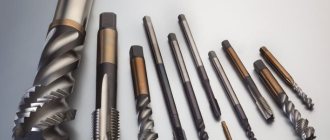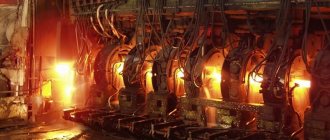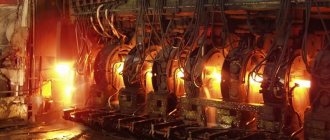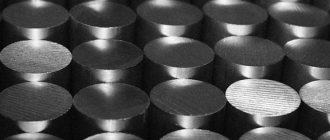Materials such as high-speed steels have unique properties, which makes it possible to use them for the manufacture of tools with increased strength. The characteristics of steels classified as high-speed steels allow them to be used to produce tools for a wide variety of purposes.
Mills, taps, reamers are typical products made from high-quality high-speed steel
Characteristics of high-speed steels
The category of high-speed steels includes alloys whose chemical composition is supplemented with a number of alloying additives. Thanks to such additives, steels are given properties that allow them to be used for the manufacture of cutting tools that can operate efficiently at high speeds. What distinguishes high-speed tool steels from conventional carbon alloys is that the tools made from them can be successfully used for processing hard materials at high speeds.
Milling a part on a professional engraving machine
The most notable characteristics that distinguish high-speed steels of various grades include the following.
- Hardness maintained when hot (hot hardness). As is known, any tool used to perform cutting processing is intensely heated during such processing. As a result of heating, conventional tool steels are subjected to tempering, which ultimately leads to a decrease in the hardness of the tool. This does not happen if high-speed steel was used for manufacturing, which is capable of maintaining its hardness even when the tool is heated to 6000. Typically, high-speed steel grades, which are often called high-speed steels, have even lower hardness compared to conventional carbon steels if the cutting temperature is within normal limits: up to 2000.
- Increased red fastness. This parameter of any metal characterizes the period of time during which a tool made from it is able to withstand high temperatures without losing its original characteristics. High-speed steels as a material for the manufacture of cutting tools have no equal in this parameter.
- Resistance to destruction. A cutting tool, in addition to its ability to withstand exposure to elevated temperatures, must also have improved mechanical characteristics, which is fully demonstrated by high-speed steel grades. Tools made from such steels, which have high strength, can successfully operate at large depths of cut (drills) and at high feed rates (cutters, drills, etc.).
Characteristics and purpose of high-speed steels
High speed steels
High-speed steel (“high-speed steel”) is a high-alloy tool steel (5.5-19% W, as well as Cr, V, Mo, C, and sometimes Co), intended for the manufacture of metal-cutting tools.
High-speed steel has high heat resistance or red-hardness (600 - 700 ° C) with high hardness (63 - 70 HRC) and wear resistance of the tool. The unique properties of the high-speed cutter are achieved through special alloying (mainly due to the presence of tungsten carbide) and complex heat treatment, ensuring a specific phase composition. For high-speed steels according to GOST 19265 - 73, it is customary to use the term “red resistance” instead of “heat resistance”.
In the operating mode of the tool, high-speed steel has an increased processing speed of the material (about 3-5 times greater) compared to tools made of carbon steels. The possibility of obtaining such a cutting speed is due to the red-hardness of high-speed steels. A tool made of high-speed steel softens when heated above 550-600°C, while a tool made of carbon tool steel softens at 200°C. The red resistance of steel is ensured by alloying elements - tungsten (W), chromium (Cr), vanadium (V), which form highly resistant carbides. To obtain the desired structure and properties, a high-speed steel tool undergoes a special heat treatment, which consists of hardening after heating to a temperature of 1240-1300°C and repeated (usually 3 times) tempering at a temperature of 560-620°C. To increase the durability of high-speed steel, cyanidation, cold treatment, step hardening, etc. are used.
High-speed steels with a high vanadium content or with the addition of cobalt, which have higher cutting properties, are also used.
High-speed steels are sometimes used in mechanical engineering for parts heated to 500-650°C, especially for so-called heat-resistant ball bearings. In addition to hardness and hardenability, the cleanliness of the quick cutter is important. (minimization of non-metallic inclusions, carbide segregation and absence of defects of metallurgical origin).
High speed steel usually has a special designation system and begins with the letter “P”. The number after the letter “P” indicates the average tungsten content in it (as a percentage of the total mass). The remaining principles of marking are the same as for other steels.
The most widely used steel grades are:
Р6М5 (W 5.5-6.5%, Mo 4.8-5.3, Cr 3.8-4.4, V 1.7-2.1, C 0.82-0.9, Mn≤0.5, Si≤0.5, Ni≤0.4, S≤0.025, P≤0.03, Co≤ 0.5)
(W 8.5-9.5%, Mo≤1.0, Cr 3.8-4.4, V 2.3-2.7, C 0.85-0.95, Mn≤0.5, Si≤0.5,Ni≤0.4, S≤0.03, P≤0.03, Co≤0.5)
P18 (W 17-18.5%, Mo≤ 1.0, Cr 3.8-4.4, V 1.0-1.4, C 0.73-0.83, Mn≤0.5, Si≤0.5, Ni≤0.4, S≤0.03, P≤0.03, Co≤0.5 )
Steels R12, R6M3, R9F5, R14F4, R18F2, R9K5, R9K10, R6M5K5, R10K5F5 are also used for the manufacture of cutting tools. Cutting tools made of high-speed steel after heat treatment (HRC 62-65) have a red hardness of 600-630 °C and have increased wear resistance; they can operate at cutting speeds of up to 80 m/min.
| Tool high speed steel | |||
| Russia, GOST | USA, AISI, ASTM, ASME | Euronorms, En, DIN, WNr | Areas of use |
| R2AM9K5 | for cutting tools when machining improved alloy and stainless steels | ||
| R2M10K8-MP | M42 | S2-10-1-8, 1.3247 | |
| R3M3F4K5(EI976) | |||
| R6M3 | for the production of finishing and semi-finishing tools of small sizes when machining structural steels | ||
| R6M4K8 | for processing high-strength stainless and heat-resistant steels and alloys under conditions of increased heating of the cutting edge: gear cutting tools, cutters, shaped cutters, countersinks, taps. | ||
| R6M5 | M2 | S6-5-2, S600/S601, 1.3343 | For the manufacture of metal-cutting and thread-cutting tools, incl. working with shock loads. Recommended for processing and cutting stainless steels, incl. heat-resistant when the cutting edge is heated |
| R6M5K5 | — | S6-5-2-5, S 705, 1.3243 | Clean and p/h processing of tools. steels, stainless in elevated conditions. heating the cutting edge. Instead of R18K5F2, as more economical. Instead of R9K5, as having higher (25-30%) dir. St. HB 269 |
| R6M5F3(DI99) | M3 | S 790PM, 1.3342/1.3344 | Finishing and semi-finishing tools: shaped cutters, reamers, broaches, cutters for processing. low-alloy and alloy structural steels. Increased propensity to decarbonize. |
| R6M5F4-MP | M4 | S 690PM | — |
| R6M5F3K8-MP | M36 | S 590PM | — |
| R6M5F3K9-MP | M48 | ||
| R6F2K8M5(EP658) | For the production of heat-resistant tools for processing high-strength, heat-resistant and stainless steels and alloys | ||
| R7M2F6-MP(DI100-MP) | Broaches, taps, end mills, reamers, shaped cutters for finishing of medium-alloy structural, corrosion-resistant steels and heat-resistant steels and alloys. Tools for cold deformation (punching, upsetting, extrusion) of carbon and alloy steels | ||
| A simple tool that does not require much grinding, for processing common structural materials. Good butt welding with St45 and 40X. HB 205-255 | |||
| R9K10(EI920) | |||
| R9K5 | Milling cutters taps for processing stainless steels and heat-resistant alloys at high cutting conditions, difficult to machine st. increased hardness. Has lower durability (up to 20-30%) compared to R6M5K5 steel | ||
| R9K10 | For the manufacture of rough and semi-finishing tools (cutters, hobs, countersinks, etc.), when processing carbon and alloy structural steels at high cutting conditions, as well as for processing stainless, high-strength steels and some heat-resistant alloys. It has lower toughness and cutting properties compared to R9M4K8 (EP688) steel. | ||
| R9M4K6S(EP722) | For the production of cutting tools for finishing heat-resistant alloys and alloyed structural steels and alloys operating under conditions of increased heating of the cutting edge; small arms parts. | ||
| R9M4K8(EP688) | Tools for processing heat-resistant and heat-resistant steels, alloyed structural steels with increased hardness, as well as corrosion-resistant, carbon and alloy steels using increased cutting conditions, high-performance gear cutting tools in cases where the use of steel grades R6M5K5 and R9K10 is not effective enough | ||
| R9M5F3 | For finishing and semi-finishing tools when machining structural steels. | ||
| R9F5 | for the manufacture of tools of simple shapes that do not require large volumes of grinding operations when processing materials with increased abrasive properties; finishing tools of simple shape when processing alloy steels and alloys. Reduced grindability and reduced technological properties in tool manufacturing compared to R6M5F3 (DI99), R12F3. | ||
| R10M2F5K8-MP | — | S 390PM | — |
| R10M3F4K8-MP | — | — | — |
| R10M4F3K10-MP | — | S10-4-3-10, 1.3207 | |
| R10F5K5(EI931) | H and H tools: cutters, milling cutters, countersinks, reamers, etc., when arr. decomposition difficult-to-process materials - stainless steel. and high strength. Art. from higher TV, heat resistant alloys, etc. Lower grindability and cutting properties on average. with R12F4K5. | ||
| P12 | Cutting tools: cutters, broaches, cutters, taps, reamers, when processing carbon alloy structural steels instead of grade P18 | ||
| R12F3 | — | 1.3318 | For finishing tools when machining tough austenitic steel and materials with abrasive properties. Special properties - reduced tendency to overheat during hardening. |
| R12K5F4-MP | — | S12-1-4-5, 1.3202,S 308PM | — |
| R12MF4-MP | — | S 207PM | — |
| R12MF5-MP(DI70-MP) | Shaped cutters, drills, reamers, countersinks, taps, broaches, hob cutters, disk cutters, end cutters, special cutters, cutters, shaver for processing high-strength steels, heat-resistant steels and alloys. | ||
| R12M3K5F2-MP(EP863-MP, DI103-MP) | |||
| R12M6F5-MP | M61 | — | — |
| R12MF5K5-MP | T15 | 1.3202 | — |
| R12F5K5-MP | T15 | S 200 | — |
| R0M2SF10-MP | A11 | CPM 10V | — |
| R12F2K5M3Sh( EP863Sh | For tools when processing high-strength, heat-resistant and stainless steels and alloys. | ||
| R12F2K8M3sh(EP657-Sh) | |||
| R12F3K10M3sh(EP682sh | |||
| R12F5M(EP772) | |||
| R13F4K5(EP600) | |||
| R14F4(EI915) | A simple tool. Cutters, countersinks, reamers. A finishing tool of simple shape for machining alloy steels and alloys. Reduced grindability compared to with R6M5F3(DI99) and R12F3. | ||
| P18 | T 1 | S 200, 1.3355 | For all types of dir. instrument. with preservation of cutting properties when heated. when operating up to 600 degrees for carbon, alloy, structural steel. durable up to 1000 MPa. Butt welding with St45, 40X is acceptable |
| R18F2(EI916) | For the manufacture of finishing and semi-finishing cutting tools, cutters, cutters, reamers, drills, when processing medium-alloy structural steels, as well as some grades of stainless steels and heat-resistant alloys | ||
| R18K5F2 | For cutting tools when machining improved alloy and stainless steels. Special properties - increased tendency to decarburization and overheating during hardening. | ||
| R18F2K8M(EP379) | For the production of heat-resistant tools for processing high-strength, heat-resistant and stainless steels and alloys | ||
| R18F2M(EI917) | for tool making | ||
| 9Х4М3Ф2AGСТ | |||
| 11M5F | |||
| 11R3AM3F2 | Hacksaw blades, drills, cutters, taps for processing carbon, low-alloy structural steels and gray cast iron. The service life of the cutting tool is the same as that of the R6M5 brand tool, but they have increased wear resistance | ||
Decoding the designation of steel grades
Initially, high-speed steel as a material for the manufacture of cutting tools was invented by British specialists. Taking into account the fact that tools made from such steel can be used for high-speed processing of metals, this material was called “rapidsteel” (the word “rapid” here means high speed). This property of these steels and the English name he invented at one time was the reason that the designations of all grades of this material begin with the letter “P”.
The rules for marking steels classified as high-speed steels are strictly regulated by the relevant GOST, which greatly simplifies the process of deciphering them.
The first number after the letter P in the designation of steel indicates the percentage content of such an element as tungsten, which largely determines the basic properties of this material. In addition to tungsten, high-speed steel contains vanadium, molybdenum and cobalt, which are designated in the markings by the letters F, M and K, respectively. After each of these letters in the marking there is a number indicating the percentage of the corresponding element in the chemical composition of the steel.
An example of decoding a high-speed steel grade
Depending on the content of certain elements in the steel, as well as their quantity, all such alloys are divided into three main categories. It is quite easy to determine which category steel belongs to by deciphering its markings.
So, high-speed steel grades are usually divided into the following categories:
- alloys containing up to 10% cobalt and up to 22% tungsten; These steels include alloys of grades R6M5F2K8, R10M4F3K10, etc.;
- steel containing no more than 5% cobalt and up to 18% tungsten; such steels are alloys of grades R9K5, R18F2K5, R10F5K5, etc.;
- alloys that contain no more than 16% of both cobalt and tungsten; These alloys include steel R9, R18, R12, R6M5, etc.
Determining the type of steel by spark
As mentioned above, the characteristics of steels classified as high-speed steels are mainly determined by the content of such an element as tungsten. It should be borne in mind that if a high-speed alloy contains too much tungsten, cobalt and vanadium, then due to the formation of carbide heterogeneity in such steel, the cutting edge of the tool that is made from it may chip under the influence of mechanical loads. Tools made from steels containing molybdenum do not have such disadvantages. The cutting edge of such tools not only does not chip, but is also distinguished by the fact that it has the same hardness indicators along its entire length.
The grade of steel for the manufacture of tools, which are subject to increased requirements for their technological characteristics, is P18. Having a fine-grained internal structure, this steel exhibits excellent wear resistance. Another advantage of using steel of this grade is that when hardening products made from it, they do not overheat, which cannot be said about high-speed alloys of other brands. Due to the relatively high cost of tools made from steel of this grade, it is often replaced with the cheaper P9 alloy.
Technical characteristics of steel grade P18
The fairly low cost of steel grade P9, as well as its variety - P9K5, which in its characteristics is in many ways similar to the high-speed alloy P18, is explained by a number of disadvantages of this material. The most significant of them is that in the annealed state such a metal is easily susceptible to plastic deformation. Meanwhile, P18 grade steel is also not without its drawbacks. Thus, high-precision tools are not made from this steel, which is explained by the fact that products made from it are difficult to grind. Good indicators of strength and ductility, including in a heated state, are demonstrated by tools made from P12 steel, which in its characteristics is also similar to P18 steel.
Properties of steel grade R9K5
What does steel grade mean and how to determine it
In world practice, there are various steel marking systems. There are no uniform standards for products due to the large number of organizations monitoring and labeling metal products. In Europe, the document EN10027 is in force, which has a similar approach to the Russian one in naming steels.
According to the current Russian standard, alloying elements are designated by Cyrillic letters, and the number indicates the amount of the element as a percentage. The absence of a digital value behind the letter means that the content of the alloying additive is from 0.8% to 1.5%, with the exception of molybdenum and vanadium whose mass fraction is lower. The absence of a number in front of the alloy steel grade means that it contains 1% carbon or more. The designation and interpretation of alloying elements of steels is given in the table
| Item name | Chemical symbol | Designation in the brand | Examples |
| Carbon | C | not specified | |
| Chromium | Cr | X | 40X; 40Х13 |
| Silicon | Si | WITH | 65SG; 30ХГСА |
| Nickel | Ni | N | 45ХН; 12Х18Н10Т-Ш |
| Manganese | Mn | G | 65SG; 30ХГС |
| Tungsten | W | IN | CHVG; Х6ВФ |
| Molybdenum | Mo | M | 12ХМ; 15N2M |
| Cobalt | Co | TO | R10F5K5; R6M5K5 |
| Titanium | Ti | T | 15ХГН2Т; 5ХНТ |
| Vanadium | V | F | 12ХМФ; 12Х8ВФ |
| Aluminum | Al | YU | 38ХМНУА; 36НХТУА |
Chromium in an amount from 1% to 4% improves the hardenability of the alloy, increases its strength and heat resistance. Various parts of mechanisms operating under high loads are made from chromium. Chromium is found in large mass fractions in stainless and heat-resistant samples.
Silicon in an amount of 1% to 1.5% increases the elastic properties of the material and is used for the manufacture of springs and leaf springs. Silicon is often included in the instrumental group.
Nickel in small proportions has a beneficial effect on impact strength and strength, and in large quantities, usually in combination with chromium, it imparts heat-resistant properties and high corrosion resistance.
Manganese content of 1% to 1.5% increases toughness, that is, its ability to withstand shock loads at low temperatures, when the material becomes brittle.
Tungsten dramatically increases red-hardness and wear resistance, which is a necessary property of cutting materials in which it is most widely used. Molybdenum , like tungsten, increases wear resistance and red-hardness, increasing resistance to oxidation at high temperatures.
Cobalt , being in the composition of steel and non-metallic cutting materials, gives them resistance to impact loads at elevated temperatures. The presence of titanium promotes fine graining in the unhardened state and also improves oxidation resistance.
Vanadium , usually combined with chromium, improves strength properties and increases resistance to oxidation at high temperatures. Aluminum increases heat resistance and scale resistance, in addition, like titanium, affecting the extraction of grain size.
Production and Processing Methods
For the production of tools made from high-speed alloys, two main technologies are used:
- the classical method, which involves casting molten metal into ingots, which are then subjected to forging;
- a method of powder metallurgy in which molten metal is atomized using a stream of nitrogen.
Classic technology, which involves forging a product from a high-speed alloy that has previously been cast into a special mold, allows such a product to be endowed with higher quality characteristics.
This technology helps to avoid the formation of carbide segregations in the finished product, and also makes it possible to subject it to preliminary annealing and further hardening. In addition, this manufacturing technology avoids the phenomenon of “naphthalene fracture”, which leads to a significant increase in the fragility of the finished product made from a high-speed alloy.
Hardening of finished tools made of high-speed alloy is carried out at temperatures that promote better dissolution of alloying additives in them, but at the same time do not lead to grain growth in their internal structure. After hardening, high-speed alloys have up to 30% austenite in their structure, which does not have the best effect on the thermal conductivity of the material and its hardness. In order to reduce the amount of austenite in the alloy structure to minimum values, two technologies are used:
- carry out several cycles of heating the product, holding it at a certain temperature and cooling: multiple tempering;
- Before tempering, the product is cooled to a fairly low temperature: up to –800.
Improvement of product characteristics
In order for tools made from high-speed alloys to have high hardness, wear resistance and corrosion resistance, their surface must be subjected to processing, the methods of which include the following.
- Saturation of the surface layer of the product with nitrogen - nitriding. Such treatment can be carried out in a gas environment consisting of nitrogen (80%) and ammonia (20%), or completely in an ammonia environment. The time required to perform such a technological operation is 10–40 minutes, the temperature at which it is carried out is 550–6600. The use of a gas environment containing nitrogen and ammonia allows the formation of a less brittle surface layer.
- Saturation of the surface layer of a product with carbon and nitrogen is cyanidation, which is carried out in a melt of sodium cyanide or other salts with the same anion. Depending on the purpose of the part, cyanidation can be done at high, medium and low temperatures. The higher the temperature and exposure time of the part in the melt, the greater the thickness of the resulting layer.
- Sulfidation, which is performed in liquid sulfide melts to which sulfur compounds are added. This procedure is carried out for 45–180 minutes, and the melt temperature should be 450–5600.
Tools made from high-speed alloys are also subjected to steam treatment, which improves the characteristics of their surface layer. It should be borne in mind that all of the above operations are performed with a tool whose cutting part has already been sharpened, polished and heat treated.










